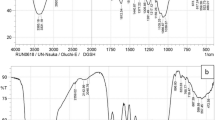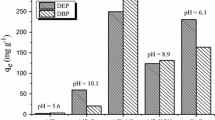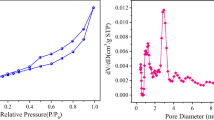Abstract
Batch kinetics and isotherm studies were carried out to evaluate the sorption of phenol by pyrolyzed and activated Jordanian oil-shale. The effects of contact time, initial sorbate concentration, sorbent concentration, temperature, pH and inorganic salts (NaCl and KCl), on the adsorption process by different sorbents were considered. Chemically activated oil shale, pretreated with ZnCl2, gave the highest uptake of phenol. The isotherm experimental data fit well to Freundlich and Redlich-Paterson models and to a less extent to the Langmuir model. The increase in the initial sorbate concentration resulted in an increase in the uptake. Three kinetics models, namely the Morris-Weber model, the Lagergren model, and the pseudo-second-order model (PSOM), were applied to represent the experimental results for pyrolyzed and ZnCl2-oil shale sorbents. Pyrolyzed oil shale was prepared using a fluidized bed reactor at 520 °C in the presence of nitrogen. Physical activation was carried out by treating the resulted pyrolyzed oil shale with CO2 at 830 °C, while chemical activation of oil shale was carried out using KOH and ZnCl2 as impregnating agents.










Similar content being viewed by others
References
Al-AsheH S, Banat F (2001) Adsorption of copper and zinc by oil shale. Environ Geol 40:693–698
Al-Zou'bi AS (1997) Adsorption of phenolic compounds from aqueous solutions onto new adsorbents. MSc Thesis, Jordan University of Science and Technology, Irbid, Jordan
Ballice L, Yuksel M, Saglam M, Schulz H (1996) Evolution of volatile products from oil shales by temperature-programmed pyrolysis. Fuel 75:453–458
Banat F, Al-Bashir B, Al-Asheh S, Hayajneh O (2000) Adsorption of phenol by bentonite. Environ Pollut 107:391–398
Banat F, Al-Asheh S (2001a) The use of human hair waste as a phenol biosorbent. Ads Sci Tech 19:599–608
Banat F, Al-Asheh S (2001b) The use of columns packed with chicken feathers for the removal of phenol from aqueous solutions. Ads Sci Tech 19:553–563
Bishop DJ, Knezovich JP, Harrison FL (1990) Behavior of phenol and aniline on selected sorbents and energy-related solid wastes. Water Air Soil Pollut 49:93–106
Boyd L, Shaobai S, Lee JF, Mortland MM (1988) Pentachlorophenol sorption by organo-clays. Clays Clay Mineral 36:125–130
Brown NMD, Meenam BJ, Taggart GM (1991) An IETS study of the adsorption of 2,3-dihydroxynaphthalene, 1,2-dihydroxybenzene, 1,3-dihydroxybenzene and 1,2-dihydroxybenzene on thin film plasma-grown aluminum oxides. Spectrochim Acta, Part A 2:219–232
Cooney DO, Wijaya J (1987) Effect of pH and salts on the adsorption of ionizable organic species onto activated carbon from aqueous solution. Engineering Foundation, New York
Darwish N, Halhouli K, Al-Dhoon N (1996) Adsorption of phenol from aqueous systems onto spent oil shale. Sep Sci Tech 31:705–714
Das A, Sharma DK (1998) Adsorption of phenol from aqueous solutions by oxidized and solvent-extracted residue coal. Ener Sour 12:821–830
Davi ML, Gnudi F (1999) Phenolic compounds in surface water. Water Res 14:3213–3219
Dutta NN, Brothakur S, Baruah R (1998) A novel process for recovery of phenol from alkaline wastewater: laboratory study and predesign cost estimate. Water Environ Res 70:4–9
Gales ME, Booth RL (1976) Automated 4AAP phenolic method. Am Water Work Assoc 68:540–548
Gupta MD, Ghosh R, Palit SK (1990) Studies on adsorption of aqueous phenol systems over NaX zeolite and the copper ion-exchanged modification. J Surf Sci Tech 6:231–240
Gu B, Schmitt J, Chen Z, Liang L, McCarthy JF (1994) Adsorption and desorption of natural organic matter on iron oxide: Mechanisms and models. Environ Sci Tech 28:38–46
Gutman AM, Sataev EV, Shvartsman AS (1990) Structural role of oxygen in oxidation of carbon black by atmospheric oxygen and its effect on adsorption activity of carbon black. Prikl Khim 63:1172–1173
Halhouli K, Darwish N, AL-Dhoon N (1995) Effect of pH and inorganic salts on the adsorption of phenol from aqueous systems on activated decolorizing charcoal. Sep Sci Tech 30:3313–3324
Hasany SM, Saeed MM, Ahmad M (2000) Adsorption isotherms and thermodynamic profile of Co(II)-SCN complex uptake on polyurethane foam. Sep Sci Tech 35:379–394
Ho YS, Ng JCY, McKay G (2001) Removal of lead(II) from effluents by sorption of peat using second-order kinetics. Sep Sci Tech 36:241–261
Jaber JO, Robert SD, Williams PT (1999) Evaluation of oil yield from Jordanian oil shales. Energy 24:761–781
Jaber JO, Probert SD (2000) Non-isothermal thermogravimetry and decomposition kinetics of two Jordanian oil shales under different processing conditions. Fuel Proc Tech 63:57–70
Kilduff JE, King CJ (1997) Effect of carbon adsorbent surface properties on the uptake and solvent regeneration of phenol. Ind Eng Chem Res 36:1603–1613
Kowalska M, Guer H, Cocke DL (1994) Interactions of clay minerals with organic pollutants. Sci Total Environ 141:223–240
Mondal K, Lalvani SB (2000) Modeling of mass transfer controlled adsorption rate based on Langmuir adsorption isotherm. Sep Sci Tech 35:2583–2599
Mortland MM, Shaobai S, Boyd SA (1986) Clay-organic complexes as adsorbents for phenol and chlorophenols. Clays Clay Mineral 34:581–585
Rodrigues I, Liompart MP, Cela R (2000) Solid-phase extraction of phenols. J Chromatogr 885:291–304
Ruiz-Beiva F, Parts RD, Marcill GAF (1984) Activated carbon from almond shells. Chemical activation. One activated reagent selection and variable influence. Ind Eng Chem Prod Res Dev 23:266–269
Srivastava SK, Tyagi R, Pal N, Mohan D (1997) Process development for removal of substituted phenols by carbonaceous adsorbent obtained from fertilizer waste. J Environ Eng 123:842–851
Stauffer HC (1981) Oil shale, tar sand and related materials. American Chemical Society, Washington, DC
Tutem E, Apak R, Unal C (1998) Adsorptive removal of chlorophenols from water by bituminous shale. Water Res 32:2315–2324
Author information
Authors and Affiliations
Corresponding author
Rights and permissions
About this article
Cite this article
Al-Asheh, S., Banat, F. & Masad, A. Physical and chemical activation of pyrolyzed oil shale residue for the adsorption of phenol from aqueous solutions. Env Geol 44, 333–342 (2003). https://doi.org/10.1007/s00254-003-0767-4
Received:
Accepted:
Published:
Issue Date:
DOI: https://doi.org/10.1007/s00254-003-0767-4




